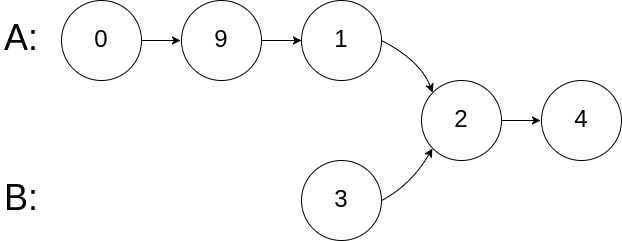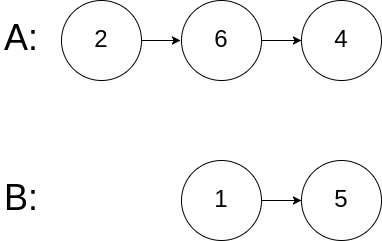面试题 02.07.链表相交
1. 题目描述
给你两个单链表的头节点 headA 和 headB ,请你找出并返回两个单链表相交的起始节点。如果两个链表没有交点,返回 null 。
图示两个链表在节点 c1 开始相交 :

题目数据 保证 整个链式结构中不存在环。
注意 ,函数返回结果后,链表必须 保持其原始结构 。
示例 1:

输入:intersectVal = 8, listA = [4,1,8,4,5], listB = [5,0,1,8,4,5], skipA = 2, skipB = 3
输出:Intersected at '8'
解释:相交节点的值为 8 (注意,如果两个链表相交则不能为 0)。
从各自的表头开始算起,链表 A 为 [4,1,8,4,5],链表 B 为 [5,0,1,8,4,5]。
在 A 中,相交节点前有 2 个节点;在 B 中,相交节点前有 3 个节点。
示例 2:

输入:intersectVal = 2, listA = [0,9,1,2,4], listB = [3,2,4], skipA = 3, skipB = 1
输出:Intersected at '2'
解释:相交节点的值为 2 (注意,如果两个链表相交则不能为 0)。
从各自的表头开始算起,链表 A 为 [0,9,1,2,4],链表 B 为 [3,2,4]。
在 A 中,相交节点前有 3 个节点;在 B 中,相交节点前有 1 个节点。
示例 3:

输入:intersectVal = 0, listA = [2,6,4], listB = [1,5], skipA = 3, skipB = 2
输出:null
解释:从各自的表头开始算起,链表 A 为 [2,6,4],链表 B 为 [1,5]。
由于这两个链表不相交,所以 intersectVal 必须为 0,而 skipA 和 skipB 可以是任意值。
这两个链表不相交,因此返回 null 。
提示:
listA 中节点数目为 mlistB 中节点数目为 n0 <= m, n <= 3 * 10^41 <= Node.val <= 10^50 <= skipA <= m0 <= skipB <= n- 如果
listA 和 listB 没有交点, intersectVal 为 0
- 如果
listA 和 listB 有交点, intersectVal == listA[skipA + 1] == listB[skipB + 1]
进阶: 你能否设计一个时间复杂度 O(n) 、仅用 O(1) 内存的解决方案?
标签
哈希表 链表 双指针
2. 解题
由于两个链表的前面部分可能不一样长,因此我们不能一次性的找到那个交点。我们可以在A链表到尾部后再连到B链表上,B链表到尾部后连到A链表上,这样的话如果前面的部分不一样长,那么第二次就一定同时到那个交点上
两个链表相交的长度为c,A链表前面的部分长度为a,B链表前面的长度为b。那么第一次到相交的起始节点时,A的指针要走a个长度,B的指针要走b个长度。这样两个指针走的长度可能会不一致。
继续走到尾部,再互相连接后,A的指针走的距离是(a+c+b),B的指针走的距离是(b+c+a),这样两个指针就会同时到相交的节点了。
如果没有交点,那么两个就会同时到null,就会直接返回null
 Documentation
¶
Documentation
¶



